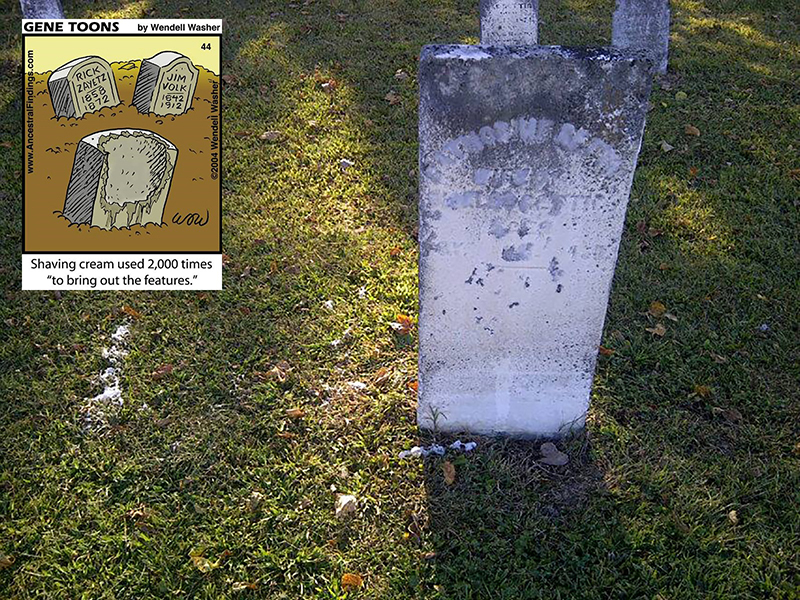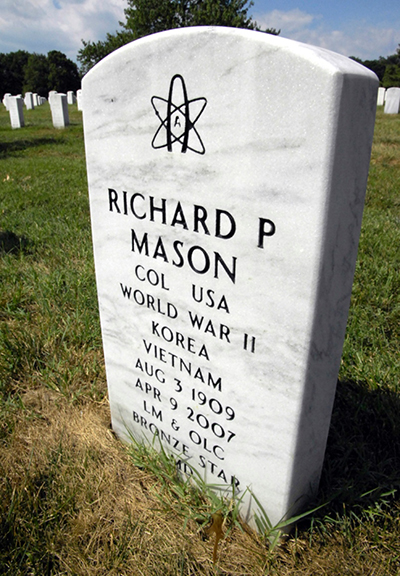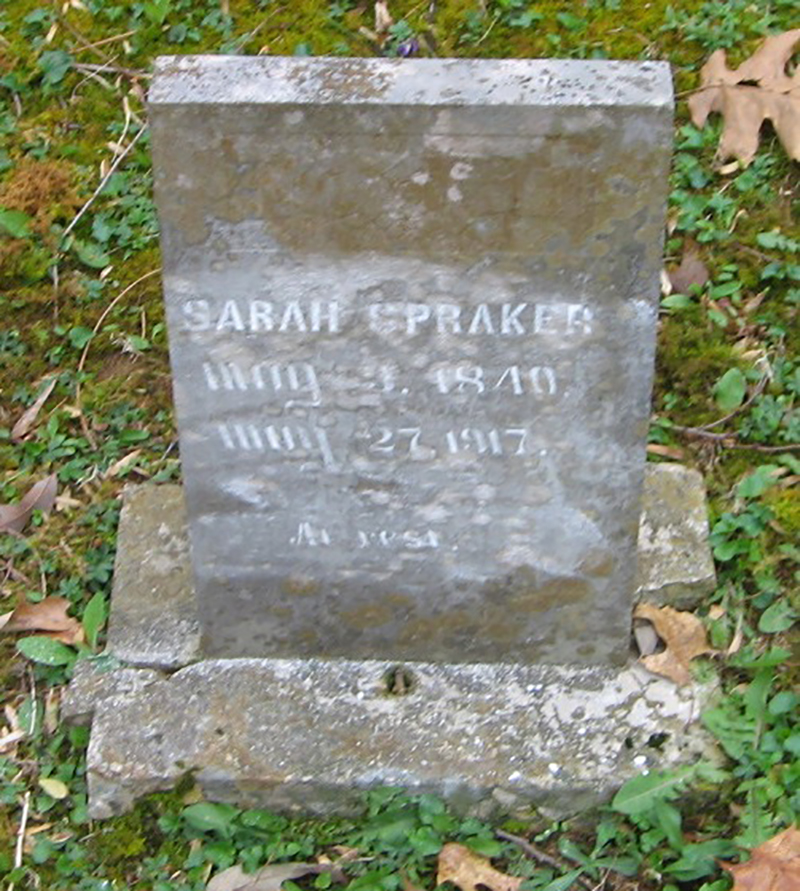The list of harmful products and methods used to read tombstones and monuments is simply huge. Over the last 50 or so years, many things have been applied to stones to achieve this. Sadly, many have become ingrained lore with organizations and individuals. Thus perpetuating damage because someone else was doing it this way long before someone new came along. Repeatedly doing the wrong thing never makes it right at the end of the day. This section is designed to explain why these methods are harmful. We encourage you to please visit our section under BASIC STANDARDS…Reading Stones, to find our list of least invasive do no harm stone reading methods. And we hope you will pass it on to the individuals and organizations you know or are part of, before the next cemetery reading adventure takes place. Together we can continue to document these historic places without inflicting damage.
Destructive Methods For Reading Grave Markers
Shaving Cream
Shaving cream shares the number one spot for most widely used damaging method for reading stones. It’s much safer on your face than on a porous stone. This in part goes back to ph. balance and the stone acting as a sponge. The following gives exacting reasons on why this is harmful.
By Mary Striegel of the NCPTT May, 2012
There are many sources that discourage the use of shaving cream on gravestones. Shaving cream includes Water, Stearic Acid, Isobutane, Laureth-23, Fragrance, Propane, Sodium Lauryl Sulfate and other compounds intended to make your face feel smooth. Grave markers can be made from many types of stone. Marble, limestone, and sandstone are sensitive to acidic compounds, depending on the particular rock and mineral formation. Shaving cream has a pH of around 5, similar to acid rain. Other compounds in shaving cream do promote biological growth, depending on where the grave stone is located. Emollients are not as water soluble as other compounds, and weathered stones are often more porous than new stones. Dirt can be more attracted the ingredients in shaving cream, even on well-rinsed surfaces.
In short, by applying shaving cream you are dowsing the stone with acid rain and attracting biological growth that will make the stone more unreadable. Biological growth also brakes down the molecular integrity of the stone.
A tombstone that has been permanently burned by the chemical reactions in shaving cream.
Chalk
Chalk is the other that shares the number one spot with shaving cream for harmful ways to read grave markers. Old marbles, sandstones, siltstones, and the like are very porous stones. If you chalk a tombstone, you are entering the following substances into the pores of the stone. Plaster of paris, silica, alumina, iron, phosphorus, and sulfur. In less significant amounts, manganese, copper, titanium, sodium oxide, potassium oxide, fluorine, arsenic, and strontium. Yes…I said arsenic. Today’s children’s sidewalk chalk is made from quite a chemical soup of things. This list also includes sodium oxide. Sodium anything is harmful to porous stones. In addition to these harmful chemicals, chalk may permanently stain the stones. Especially if it is colored chalk.
Paints and Markers
Permanent harmful methods with an immediate result include, paints and ink markers. Methods such as these simply permanently deface a grave marker and may be viewed in many communities by law enforcement as vandalism. Pens and markers permanently stain the stones, and paint does the same thing. Paint also effects the stone by acting as a sealant and in turn not letting its sponge like quality take moisture in and out. Simply, the stone quits breathing and may trap water inside that will cause it to break in a freeze, or rot from being water logged. And once again, you are introducing a plethora of chemicals into an old porous stone.
Please don’t paint old tombstones unless they were intended that way. And even then, consult a cemetery preservationist or monument company expert. Cemeteries spend thousands of dollars each year to remove paint.
Household Cleaners
Household cleaners that can be harmful if used to read grave markers include, soaps, cleansers, bleaches, ammonia, detergents, and peroxide. These products are harmful as well due to the nature of their chemical makeup. Almost all modern soaps and cleaners are made the following way.
Soap is a mixture of sodium salts of various naturally occurring fatty acids. Air bubbles added to a molten soap will decrease the density of the soap and thus it will float on water. If the fatty acid salt has potassium rather than sodium, a softer lather is the result.
Soap is produced by a saponification or basic hydrolysis reaction of a fat or oil. Currently, sodium carbonate or sodium hydroxide is used to neutralize the fatty acid and convert it to the salt.
General overall hydrolysis reaction:
fat + NaOH —> glycerol + sodium salt of fatty acid
Although the reaction is shown as a one-step reaction, it is in fact two steps. The net effect as that the ester bonds are broken. The glycerol turns back into an alcohol (addition of the green H’s). The fatty acid portion is turned into a salt because of the presence of a basic solution of the NaOH. In the carboxyl group, one oxygen (red) now has a negative charge that attracts the positive sodium ion.
Again the problem with most cleaners not being appropriate for stones is their sodium content.
Household Baking Items
Dry powdery household products that are not recommended for reading tombstones include, flour, cocoa, cornmeal, powdered sugar, baking soda, and baking powder. Typical baking ingredients from the kitchen should stay in the kitchen and be used in meal preparation. These items are by far the least harmful in comparison to those above. But because these products are of a perishable nature and are used in food preparation, they will rot, mold, and form yeasts. Covering a tombstone in these items is like creating a giant petri dish. The left over powders will work into the porous parts of the stone and engravings forming biological growths.
Further Information on this Subject from other Sources
Courtesy of CCUS member Cynthia Nicols cemetery preservationist from Indiana
A source from headboards of stone blog August 2010
A NOTE ABOUT SHAVING CREAM, FLOUR etc.
A word of advice, DON’T use shaving cream, flour or anything else on tombstones!. These have many ingredients harmful to tombstones (like butane) and in some cases can be abrasive. There are a number of websites that promote this method, with one going so far as to assure that the shaving cream will not harm the stone. Please do not attempt this as you WILL be causing a great amount of damage to the stone and even by washing it after you are finished you will not remove all of the material that you have placed on the stone.
Read More
Some Crossover Information from Cleaning to Reading Stones
Courtesy of CCUS member Scott Banker cemetery preservationist from New York State
A source from Eastman’s Online Genealogy Newsletter December 2016
How NOT to Clean a Tombstone for Photography!
Take a look at the picture below. Do you see something wrong with it? Almost every genealogist will cringe when viewing a picture like this one from Find a Grave.com. Someone apparently used a wire brush to make the engravings on the tombstone easier to read. AAARRRGGGGHHH!
The above photo is from findagrave.com
Using a wire brush on a tombstone or any other stone memorial causes irreparable damage! In fact, the damage is so severe that most states in the USA and also governments in many other countries have laws prohibiting such actions. Under the laws of many states, unauthorized tampering with or damaging gravestones is a felony. Read More





